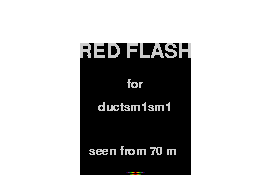

Notice how suddenly the flash appears below the duct. Even after the normal disk color fills its center, the blob retains a very prominent red rim.
These red flashes are quite common, but few people notice them because they are usually not very different in color from the rest of the Sun. Because they appear in a zone of large refraction, the extinction is large, and the brighter light filling the center of the blob is often nearly the same hue as the red rim itself.
(The connection between large refraction and large extinction and reddening is Laplace's extinction theorem, if you're interested in such technical details.)
There's a nice animation of a real sunset with a good red flash at http://www.pbase.com/warthog2100/image/52579824; the red flash comes at the 8th frame of the series. You can still see the red rim for a couple of frames past the red flash. (If you use mozilla, you can stop the animation at the red-flash frame by hitting the <ESC> key just as it appears; reload the page to re-start the animation.) This sunset also shows the relation between the red and green mock-mirage flashes produced by the same inversion.
Notice how the lower limb of the Sun flattens out just above the inversion that causes the red and green flashes that follow it. That inversion wasn't quite strong enough to produce a duct, so the image isn't quite discontinuous. The second inversion, at the sea surface, produces the “long line” that's typical of Fisher's type B sunsets. Because the thermal structure in the real sunset is more complex than the simple models used in the simulations, the shape of the red flash is also more complex and distorted in the real sunset.
That sunset is also notable for the calmness of the sea: notice that you can still see a patch of glitter at the horizon, just below the Sun, well into the sequence. Usually the glitter has disappeared at the horizon several minutes before sunset. Most of the glitter-path retreats toward the camera in the first few frames, but that patch of smooth water continues to show it for a couple of frames past the red flash.
The photographs also show examples of some common artifacts: the overexposed Sun is yellow, or even white, although it should really be about the same hue as the red-orange sky around it. A couple of the most-overexposed frames (after the red flash) also show faint, inverted “ghost” images of the Sun.
© 1999 – 2002, 2005, 2006 Andrew T. Young